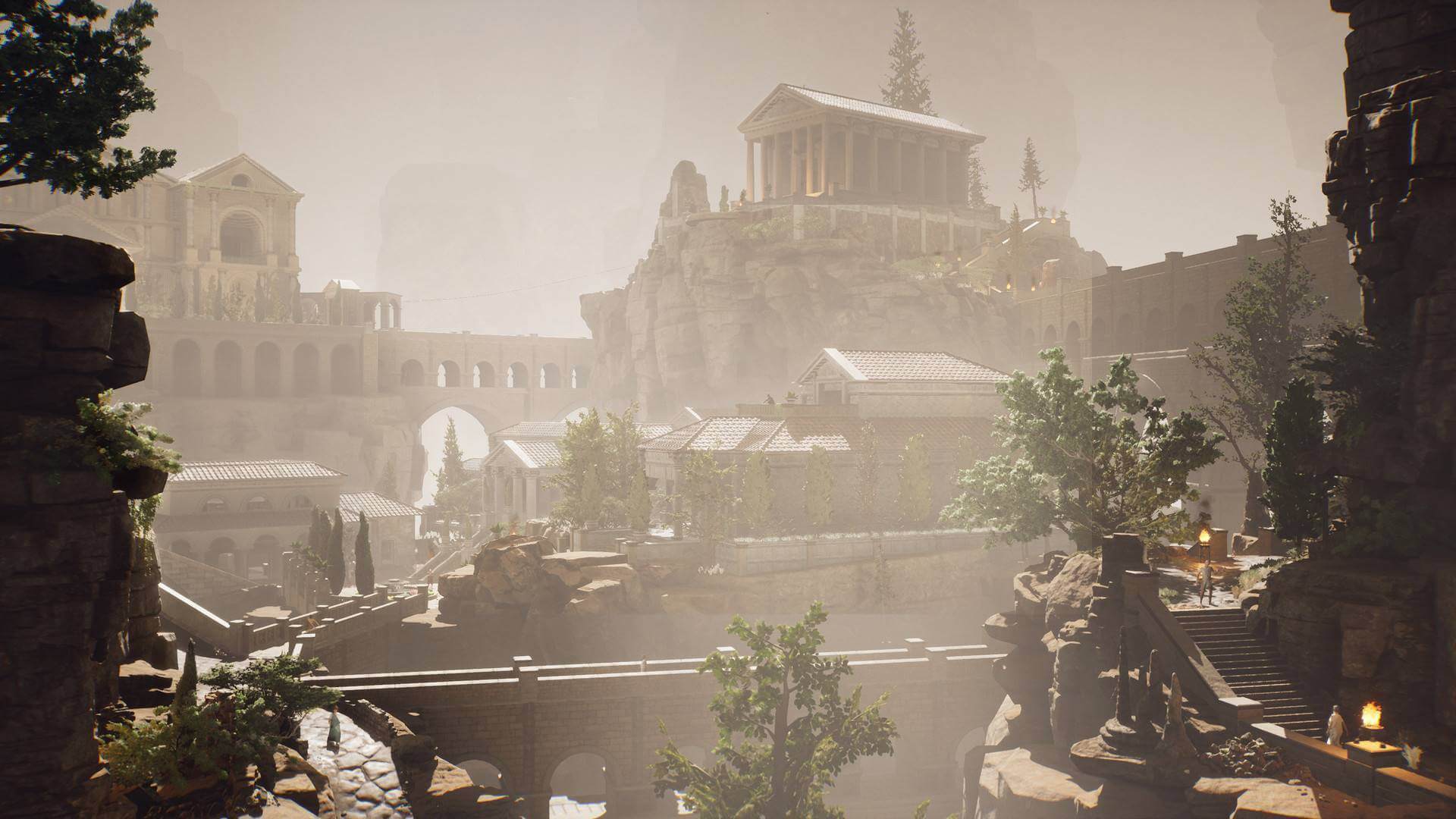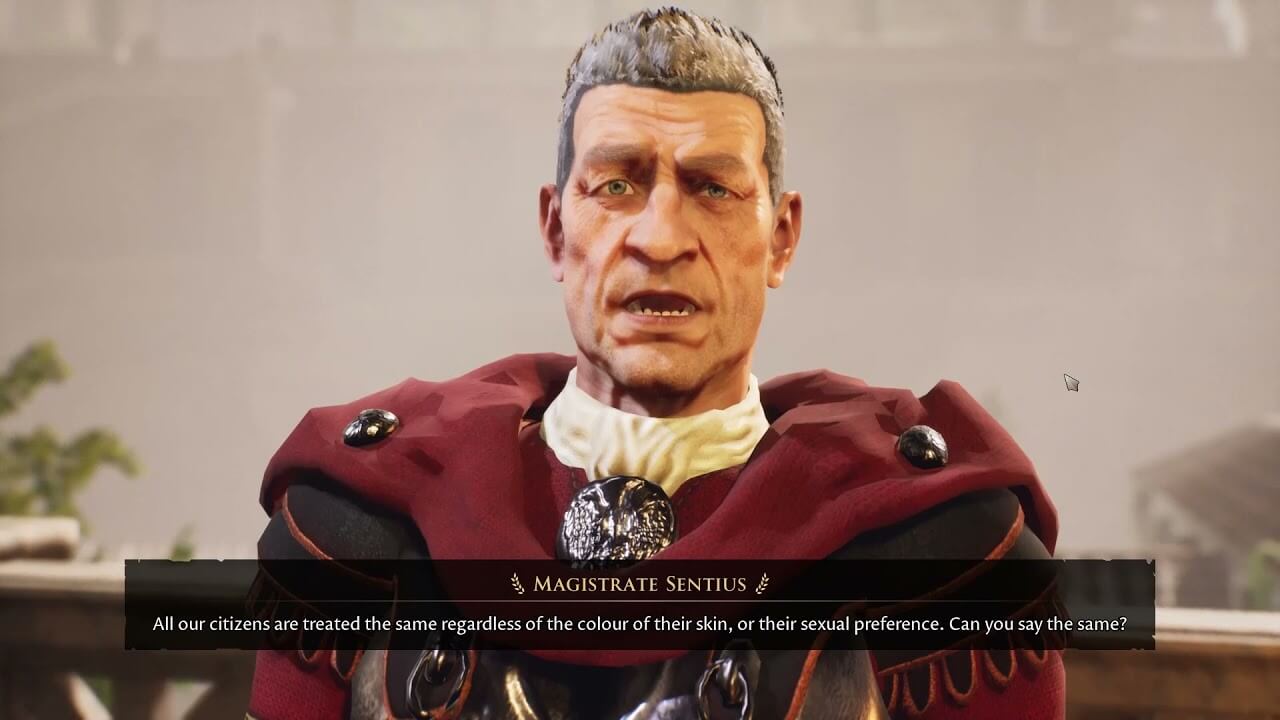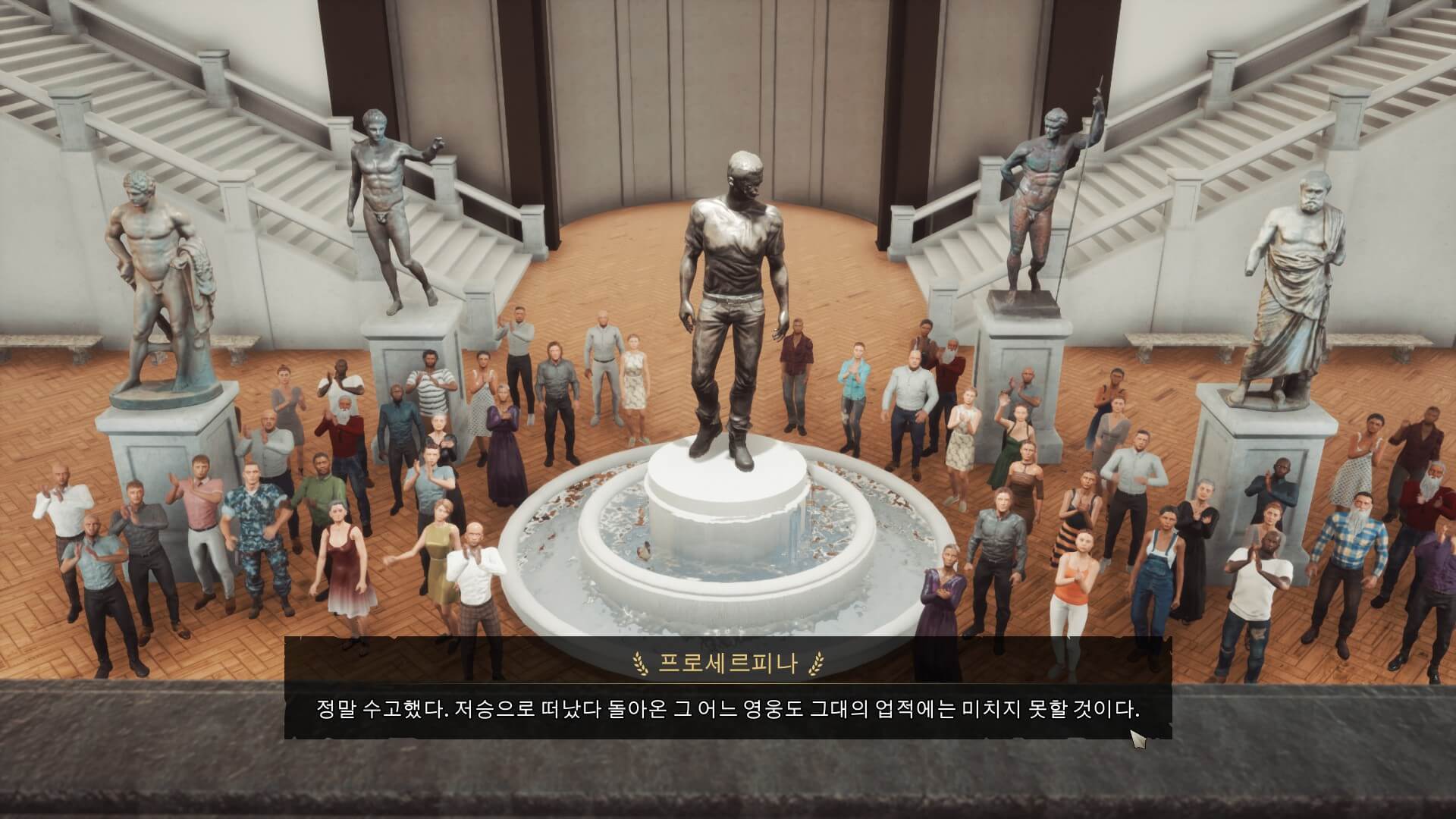 [Review] The Forgotten City
[Review] The Forgotten City
"Thus, the player’s presence in The Forgotten City’s world renders it meaningless."
Keep reading →


 [Review] The Forgotten City
[Review] The Forgotten CityJULY ♱ 27 ♱ 2023

"The Forgotten City is a mystery adventure game of exploration and deduction, and a re-imagining of the critically acclaimed mod that won a national Writers’ Guild award and racked up over 3 million downloads.
Travel 2,000 years into the past and relive the final days of a cursed Roman city, where if one person sins, everyone dies.
Combat is an option, but violence will only get you so far. Only by questioning an intertwined community of colourful characters, cleverly exploiting the time loop, and making difficult moral choices can you hope to solve this epic mystery. Here, your decisions matter. The fate of the city is in your hands."
Man, what a pitch. Murder mystery? Exploration? Right up my alley, so I bought it. A couple of minutes in and I was seriously considering requesting a refund. Why? Because of one of the most pathetic jokes I’ve been subjected to in a videogame: a character’s reluctance to tell you her name due to its recently acquired viral infamy. The name in question was Karen, by the way. I don’t even know where to start with this. I suppose I’ll just say this wasn’t funny three years ago, and it gets less funny every day. I have no issue admitting I was seriously outraged, guys, and feared this was representative of the rest of the writing in the game. You would consider a refund in my place, too. But it just so happens that my tolerance for questionable writing has been building up over the years (thank you, Kodaka; thank you, otome games), so I pushed through. I’m glad I did. Not because I was pleasantly surprised (imagine explaining basic elements of your country’s culture in casual conversation like a high school textbook from the future would), but because, if you’ll allow my earnestness, it has inspired me to share this with you today.
See, I’ve been playing some games in preparation for a video on Paradise Killer. Open-world games, to be more specific, and my experience has been varied, but very insightful. So when I came across this one and saw that it promised an open-world detective game, I noted the obvious similarities with Paradise Killer and convinced myself I needed to play this for research. Yeah, right. I’ll tell you how it went, but first, let me get us on the same page.

Please let it go.
In The Forgotten City, you play as someone (name, gender, skin tone, and background to be chosen by the player) who’s stumbled upon some Roman ruins (yes, this happens after the Karen incident) and somehow traveled back in time to the small, secluded Roman city those ruins belong to. In this place, even if only one person sins, everyone there dies. “What constitutes a sin?”, you ask. Right, that’s one of the philosophical questions the game intends to explore. Anyway — that’s not all: whenever this rule is broken (by the player or by other characters), you go back in time because, as it happens, you’re stuck in a time loop. So back to the beginning in order to find out who’s about to break the “Golden Rule”, and how to prevent them from doing so.
Now, I’ve played a decent amount of time loop adventure games in my life. And yet, The Forgotten City’s rendition of the time loop mechanic took me completely by surprise. I made sure to avoid the specifics before, so let me explain: whenever someone breaks the Golden Rule, you don’t get a game over screen and automatically start from the beginning. You still have one job to do: run. The “Golden Rule” name recovers its full meaning at this moment, as the golden statues scattered around the city wake up and start attacking you with their bows, decimating your health bar with every arrow you fail to dodge. Your mission is to avoid them however you can and reach the shrine of Proserpina, where a time portal is opened so that you can go back to the start of the loop. If the golden statues kill you, however, that’s an actual game over that forces you to load a previous save file.
This survivability aspect is a refreshing addition to a formula that rarely applies any friction to the looping process. It also requires a prismatic level design, in the sense that while there’s an immutable point of destination in the shrine of Proserpina, the point of origin could be anywhere (open world, remember?) The Golden Rule might be triggered while you are at the theater, lost in a dark passage, or right at the door of the shrine of Proserpina. In the first case, your route might not be too difficult, provided you’re familiar with the layout of the city. The second one, however, presents a different set of obstacles: narrow hallways make it harder to avoid the golden statues, and it's easy to get lost in the branching caves. But getting familiar with this place carries important advantages, too, as it can be used as a shortcut. Finally, if the Golden Rule finds you at the shrine’s doorstep, you're just lucky. More likely, though, you predicted or even staged the breaking of the Golden Rule’s timing and ran ahead so that it caught you in the safety of the shrine.

Unfortunately, though sometimes mandatory, action is by no means the focus of the experience. The execution of these sequences is hardly as exciting or effective as I described it. For one, the Golden Rule takes an extremely long time to get broken by one of the NPCs without the player’s intervention, damaging the element of surprise. Also, you can use the saving function liberally, and most of the statues trying to kill you only wake up with your presence so that unpredictable situations created by the other character’s interactions with the statues are off the table. If you identify an insidious tendency here, you’re not alone. If you don’t, that’s fine: we’ll talk about it later.
This game differs in another important aspect, although it might seem trivial at first. A time loop that requires you to physically go through a time portal also allows you to keep your belongings. Let’s say you go through the trouble of obtaining the key to a door in Outer Wilds, another time loop videogame. You can’t simply restart the loop and go straight to the door first thing in the morning, expecting to have the key in your inventory, because there is no object permanence across loops, just acquired knowledge and experience. In The Forgotten City, however, that’s exactly how you would go about it.
You wouldn’t expect it, though. I mean, at first glance, I would associate item-based progression with a more materialist design philosophy, rather than an idealist one. Isn’t this a videogame about talking to characters, learning the truth, and using it to debate your way forward, hopefully towards a good ending? This premise alludes to an idealist understanding of (his)story as a battle of ideas, in which the superior ones end up producing change: when you’re not defeating a guy pointing an arrow at your face by means of debate, you’re dunking on a Roman senator for liking slavery. Not to mention the game’s central fixation: the rather underwhelming observation that Romans copied the ideas of the Greeks who copied the ideas of the Egyptians, etc.
Even so, The Forgotten City’s design decides to take a materialist route: material reality, and not ideas, is what pushes the story forward; narrative change is object-dependant. A character will die without an antidote the local merchant is selling at an exorbitant price, and arguing about the immorality of the situation with him will get you nowhere. Just steal it. You will trigger the Golden Rule in the process, and then you take the antidote with you to the past: problem solved. Later on, you could confront someone about a lie, a useless pursuit without having an incriminating letter in your inventory to support your accusation. Changes in material reality, achieved through an inventory system, are the way to progress the story.

Unfortunately, well, picture this: you ask the merchant how much for the antidote. “If you get a job, work hard, and save your coins, you should be able to afford it within, say, five years?”, he answers. Let’s say you then steal it, go to the shrine of Proserpina, and travel back in time as I described before. Now, you rush to deliver the antidote to the person in need. Well done, you saved a life. After this, you decide to check your inventory. Why not? And you find out: you gave it to someone, but get this, the antidote is still there. Strange. Now, let’s say you go through this whole process again. You will still have the antidote, now with a “(2)” next to it. I wonder, will the game system let you see a “(99)”, a “(999)”, perhaps? How much hard work do you guys reckon is five years multiplied by 999?
It’s such a sloppy decision, making an item-based progression game and not designing a resource management system (or an aesthetically relevant alternative) to go with it. It would seem like a petty complaint, but the way items are implemented in the game carries ideological implications. For one, there are many daily-use items scattered around the city, yet no character is ever seen interacting with them, physically or not. They aren’t used by these people as ordinary objects; the existence of these props is limited to the player’s inspection through a disembodied zoom, museum plaque-like description at your service and all.
As for the antidote example, it’s tempting to write it off as a band-aid for a quality-of-life-related problem (if we are generous) and move on. This would be ignoring the fact that this aspect of the execution of the inventory system is inadvertently creating a hoarding mechanic. What’s the difference between the merchant, whose power lies in his ability to hoard a bottle of medicine, and the player, who can hoard God-knows-how-many of them and choose whether to share them or not? Very simple: the difference is that the merchant’s hoarding characterizes him as a villain, and the player’s ability to hand out antidotes with no limits characterizes them as a hero.
Long story short, it’s fucking weird to be the guy who has five different bows in a city that has made a point of banishing weapons, who goes around with an endless supply of medicine in a city where people die without access to it, and for every character to just… shrug at all of that. You are at the same time above and in the center of their lives. Thus, the player’s presence in The Forgotten City’s world renders it meaningless.
Remember that “insidious tendency” I hinted at earlier? It’s one The Forgotten City shares with practically all of the AAA videogames it aspires to emulate: the individualistic imperative to coddle the player with a world that’s been created around them to make them feel powerful and important. So, it makes sense that the true ending features a jerk-off hallway in which the characters (who have been sent to the future, least the player doesn’t have one last feel-good moment) tell you about how amazing their present-day middle-class lives are, and how it’s all thanks to you. At the end of this hallway, a God (yes, a God) awaits you to personally thank you for saving them. The archeologist next to them tells you ancient tablets describing your deeds have been found in the ruins — history will know you as a hero. And after that, you are informed there are yet more people who want to thank you. You look down, and a crowd starts clapping for you. Don’t you remember them? They are the golden statues with buggy AI, now acting normal.

I hope you guys can't read Korean because the text is fairly spoiler-y but yeah, that's YOUR statue in the middle.
In the end, The Forgotten City is an unfortunate mix of technical shortcomings and conservative design choices that, instead of producing mere deficiencies, create meaning in their own right. The restricted enemy AI pushes forward the idea that the player’s avatar is more important than everybody else, and that’s why most of the golden statues don’t react to other characters’ presence. This is a ridiculous notion, considering your mission is to save these people from their seemingly inexorable end at the hands of the statues. The same goes for the previously discussed inventory system and how it allows you to defy the moral code of the city without anyone ever confronting you about it. We shouldn't understand these elements as bugs but as features, especially when they are consistent with the game's unflinching dedication to shamelessly stroke the player's ego.


 [Review] The Forgotten City
[Review] The Forgotten City"Thus, the player’s presence in The Forgotten City’s world renders it meaningless."
Keep reading →

"This avatar, a pure extension of the player, embodies a cult leader to a degree few others I know have reached (the irony of this happening in a narrative that calls into question that exact dynamic wasn’t lost on me). Whether a cause is just or not depends on the side the avatar defends. I mean, even the Black Eagles route, regarded as the most immoral of the three in general, makes a laughable attempt to antagonize the other side beyond the original frame of moral ambiguity. You always made the right choice, did the right thing. Any student you want on your side wants to be on your side. They aren’t loyal to anything, and you’ll find them expressing polar opposite opinions on different routes. They’re sunflowers to the sun."
Keep reading →

For a couple of years now, there’s been a lot of talk about a so-called Indiepocalypse. Developers and players alike worry that the exorbitant amount of videogames that are released on Steam every day are saturating the market, making it harder for indies to get their rightful spotlight. And I get it, to some extent. Indie Game: The Movie sold us a fantasy that’s out of reach for most, and that realization is just now dawning on those developers who were inspired by it. I’m empathetic to these folks, but my empathy has a limit. You can find it right at the scapegoat some of them found for this structural problem: bad games.
Keep reading →

"A lot of these videogames are so insecure about their alleged lack of gameplay that they introduce small doses of interactivity here and there. Sometimes in the shape of quick-time events, other times in the shape of sterile puzzles. Life is Strange 2 has both. I remember the first one appearing when you try to convince Daniel to come with you. You have to win this microgame multiple times for him to do so as if you “kept trying no matter what”. And look, that’s the problem with this videogame imposter syndrome: it always leads to puerile ludic metaphors."
Keep reading →

"In this videogame, you don’t use social media as we know it, but the philosophy behind it—hyper-vigilance, centralization, inescapable corporate ownership and control of user-generated content—is the basis of this world. Hypnospace might look like the past, but it speaks like the present."
Keep reading →

"Polly Pocket has always been about evoking a dimensionality other dollhouses couldn’t have. They were the size and form of a makeup kit, and when you opened them, one half would be perpendicular to the other, thus conveying horizontality and verticality simultaneously."
Keep reading →

"As advocacy journalism turned into fiction, it lacks earnest execution, while as a personal/universal narrative, it lacks a heart. Bury Me, My Love isn’t exploitative, but is for sure a palatable gamification of a conflict that doesn’t want to confront me."
Keep reading →
